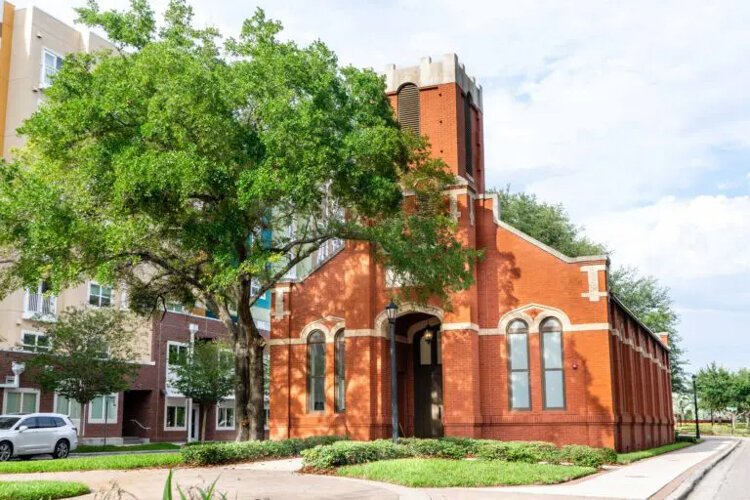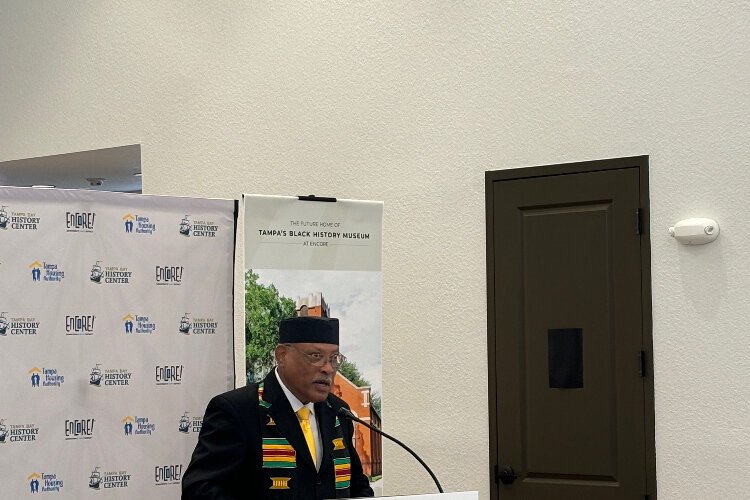The Tampa Housing Authority has long considered the historic St. James Episcopal Church building in downtown Tampa as a possible site for a Black history museum.
As the Housing Authority demolished the Central Park Village public housing community and developed the mixed-use, mixed-income Encore neighborhood, the authority renovated the historic circa 1921 church building.
Last Juneteenth, the museum came closer to reality when the Housing Authority and the Tampa Bay History Center partnered to launch St. James @ Encore, a history center initiative that offers cultural, historical and educational events and programs in the church building.
This Juneteenth, the museum will officially open: The Housing Authority and History Center announced that St. James @ Encore will become Tampa’s Black History Museum, a home for exhibits and artifacts that tell the story of Tampa’s rich Black history and culture.
Preserving and celebrating Tampa’s black history
During a June 17 ceremony at St. James, Fred Hearns, the history center’s black history curator, said the church building at 1213 N. Central Ave. may be the perfect location for the museum.

 Tampa Bay History CenterHistoric St. James Episcopal Church will become Tampa’s Black History Museum through a partnership between the Tampa Bay History Center and the Tampa Housing Authority. In addition to its own historical significance, St. James stands in the area of The Scrubs, once Tampa’s oldest and largest African-American neighborhood, a community that was home to former slaves and later Central Park Village, a public housing community that opened during segregation and existed for more than 50 years.
Tampa Bay History CenterHistoric St. James Episcopal Church will become Tampa’s Black History Museum through a partnership between the Tampa Bay History Center and the Tampa Housing Authority. In addition to its own historical significance, St. James stands in the area of The Scrubs, once Tampa’s oldest and largest African-American neighborhood, a community that was home to former slaves and later Central Park Village, a public housing community that opened during segregation and existed for more than 50 years.
The Central Avenue corridor was once the heart of a thriving black business and entertainment district known as the “Harlem of the South.” In the late 1940s, Ray Charles lived “just a stone’s throw away” from the St. James and recorded his first record, Hearns says. For $2.50, you could hear jazz legend Louis Armstrong play trumpet in a Central Avenue club. Tampa became a “second home” for soul legend James Brown because of his friendship with Central Avenue business owner and civil rights activist Moses White, Hearns says.
“You don’t have to look far to find history,” he says.
Civil rights leader Robert W. “Bob” Sanders Sr. grew up in West Tampa and returned to the city after serving in the military during World War II, where he wrote a column for the Florida Sentinel-Bulletin called “Central Avenue Buckshot,” which detailed life on Central Avenue, according to the University of South Florida Library.
Later, after the Ku Klux Klan murdered Florida’s first NAACP field director, Harry T. Moore, and his wife, Harriet Moore, Sanders returned to Tampa to serve as Florida’s NAACP field director.
“Imagine taking a job where your predecessor was assassinated by the Ku Klux Klan,” Hearns said. “How many people would have been willing to take that job in 1952, which was very dangerous, to leave Detroit, come back to Tampa and take the job as president of the NAACP? That’s what Bob Sanders did. He held that position for 14 years and did a great job.”
 Christopher Curry Fred Hearns, Curator of Black History, Tampa Bay History Center
Christopher Curry Fred Hearns, Curator of Black History, Tampa Bay History Center
At the July 17 event, state Rep. Diane Hart said with Juneteenth Day just days away, she remembered that St. James was the cornerstone of a historic neighborhood that formerly enslaved people called home.
“The creation of this history museum will ensure that despite attempts to forget America’s original sin of slavery, discrimination and violence against Black people, future generations will not only learn about these horrific events, but will also learn from them,” Hart said.
The museum will be a natural connection to the adjacent Perry Harvey Sr. Park, where public artworks tell the story of notable figures and events in Tampa’s Black history. The city park, which showcases Tampa’s Black history and culture, has faced challenges in recent months.
Last October, several murals in the park were vandalized, destroying thick glass tiles. The city of Tampa brought in the artwork’s original artist, Rufus Butler Seder, and his team to restore the murals. This month, Gov. Ron DeSantis vetoed $500,000 in state funding to build an amphitheater at the park.
“I was devastated,” Tampa City Councilwoman Gwen Henderson said at the event June 17. “It felt like I’d lost. It felt like I’d lost the election. I felt really awful because I was so excited to be able to share this with the community.”
 Tampa Bay History CenterTampa City Council Member Gwen Henderson speaks at an event announcing Tampa’s Black History Museum.
Tampa Bay History CenterTampa City Council Member Gwen Henderson speaks at an event announcing Tampa’s Black History Museum.
But Henderson said he is discussing alternative options to get the amphitheater project done with the Tampa Downtown Partnership and Tampa Mayor Jane Kastl, who also spoke at the June 17 event.
Advance
Currently, the Tampa Bay History Center is in the early stages of planning exhibits for the museum. They are gathering public input and looking for historical artifacts, oral histories and ambassadors to help with programming and visitor engagement.
For more information, visit Tampa’s Black History Museum.
For previous articles, see Ashley Morrow: Shining a Light on Tampa’s Black History.
The Tampa Housing Authority and the Tampa Bay History Center are partners with Historic St. James Episcopal Church.


